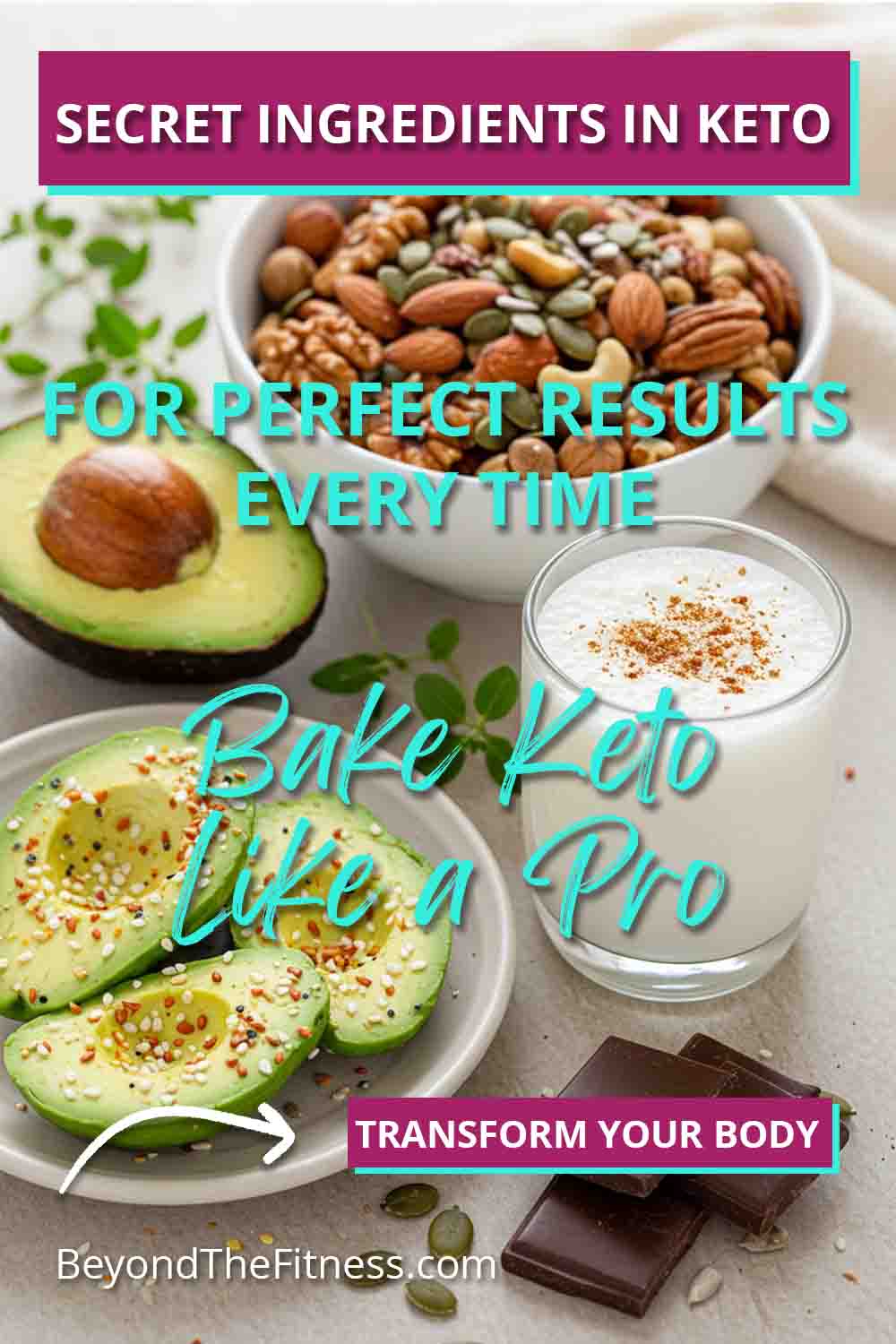Switching to a ketogenic lifestyle doesn’t mean giving up baked treats. Trust me, I love a good muffin or cookie just as much as the next person. But keto baking is a different world compared to traditional baking. You can’t just swap regular flour for almond flour one-to-one and expect magic. It took me a lot of trial and error, a lot of crumbly cookies and dense cakes, before I figured out the keys to success.
The main challenge? We need to replace two fundamental ingredients: high-carb flour and sugar. These provide structure, texture, moisture, and sweetness in traditional recipes. Finding low-carb alternatives that mimic these properties is the core of keto baking. It’s about understanding the unique characteristics of keto-friendly ingredients and how they interact. Getting this right means you can enjoy delicious baked goods that support your health goals, keep your blood sugar stable, and satisfy those cravings without derailing your progress. Let’s dive into the secret ingredients that make it all possible.
Understanding Why Keto Baking is Different
Before we get into specific ingredients, let’s quickly recap why regular baking ingredients don’t work for keto.
You Might Be Interested In: Delicious Keto Meals Tailored to Your Needs With Custom Keto Diet
- Flour: Traditional flours like wheat flour are packed with carbohydrates. Gluten, the protein in wheat, creates elasticity and structure. Keto flours lack gluten and have very few carbs, so we need different ingredients to achieve similar results.
- Sugar: Regular sugar (sucrose), honey, maple syrup, and agave are high in carbs and sugars that spike blood sugar and insulin levels, kicking you out of ketosis. We need sweeteners that provide sweetness without the carbs or the blood sugar impact.
Keto baking aims to create treats that are:
- Very low in net carbohydrates.
- Moderate in protein.
- High in healthy fats.
- Delicious and satisfying.
Achieving this requires a special toolkit of ingredients.
Keto Flours: The Foundation
Flour provides the bulk and structure of baked goods. In keto baking, nut and seed flours take center stage.
Almond Flour: The Go-To Choice
Almond flour is probably the most popular keto flour, and for good reason. It’s made from finely ground almonds, usually blanched (skins removed) for a finer texture and lighter color.
- Properties: It has a slightly sweet, nutty flavor and adds moisture to baked goods. It creates a texture that’s often denser and more tender than wheat flour.
- Types: You’ll see “almond flour” (finely ground, blanched) and “almond meal” (coarser ground, sometimes with skins). For most cakes, cookies, and delicate pastries, I recommend blanched almond flour for the best texture. Almond meal can work well for crusts or more rustic recipes.
- Best Uses: Excellent for cakes, cookies, muffins, pancakes, pie crusts, and breading.
- Nutritional Perks: It’s a good source of vitamin E, magnesium, and healthy fats.
- Things to Note: Almond flour can make baked goods a bit dense if not combined with other ingredients or leavening agents properly. It also browns faster than wheat flour, so keep an eye on your oven temperature or baking time. It tends to be more expensive than traditional flour. Because it contains fat, store it in the fridge or freezer to prevent it from going rancid.
Coconut Flour: The Super Absorber
Coconut flour is another keto staple, made from dried, ground coconut meat after most of the oil has been extracted. It behaves very differently from almond flour.
- Properties: It’s extremely absorbent, meaning you need much less of it compared to almond or wheat flour. A little goes a long way. It has a subtle coconut flavor (which can be masked by other ingredients) and creates a softer, lighter texture when used correctly.
- Best Uses: Great for cakes, muffins, and thickening sauces or fillings. It often works best when combined with other keto flours like almond flour to balance the texture.
- Nutritional Perks: Very high in fiber and contains medium-chain triglycerides (MCTs), a type of fat that’s easily used for energy.
- Things to Note: This is the crucial part – because it’s so absorbent, you absolutely cannot substitute coconut flour 1:1 for almond flour or wheat flour. You typically need only about 1/4 to 1/3 cup of coconut flour to replace 1 cup of other flours. You also need to significantly increase the liquid (like eggs, milk, or oil) in the recipe to prevent the final product from being dry and crumbly. I usually add an extra egg for every 1/4 cup of coconut flour used, plus potentially more liquid.
Other Keto Flour Options
While almond and coconut are the main players, other flours can be useful:
- Flaxseed Meal (Ground Flaxseeds): Adds moisture, binding properties, and a slightly nutty, earthy flavor. Great for breads, muffins, and crackers. Rich in fiber and omega-3 fatty acids.
- Sunflower Seed Flour/Pumpkin Seed Flour: Good nut-free alternatives to almond flour. They can sometimes lend a slightly green tint to baked goods due to a natural compound reacting with baking soda, but this is harmless.
- Hazelnut Flour: Similar to almond flour but with a distinct hazelnut flavor. Wonderful in specific recipes like brownies or chocolate cakes.
- Lupin Flour: Made from lupin beans, it’s high in protein and fiber, low in carbs. It has a slightly bitter taste that needs to be masked with other flavors. It provides good structure, especially for breads. Be aware that lupin is a legume and can be an allergen for those with peanut allergies.
Often, the best results come from blending different keto flours to achieve the desired texture and structure.
Keto Sweeteners: Replacing Sugar Wisely
This is where many people get tripped up. Keto sweeteners need to provide sweetness without adding carbs or significantly impacting blood sugar.
Erythritol: The Popular Bulk Sweetener
Erythritol is a sugar alcohol found naturally in some fruits. It’s become very popular in keto baking.
- Properties: It looks and feels much like granulated sugar. It’s about 70% as sweet as sugar, so you might need slightly more. It has a minimal impact on blood sugar and insulin. Some people notice a slight “cooling” sensation on the tongue.
- Benefits: Zero net carbs, zero calories (mostly excreted unchanged). Generally well-tolerated digestively compared to other sugar alcohols like xylitol or maltitol, though large amounts can cause issues for some sensitive individuals.
- Forms: Available in granulated and powdered (confectioners’) forms. Powdered erythritol is best for frostings, glazes, and smoother textures as the granulated form doesn’t always dissolve completely and can leave a gritty texture. You can make your own powdered version by blending granulated erythritol in a high-speed blender.
- Uses: Great all-purpose sweetener for cakes, cookies, muffins, and more. Often blended with other sweeteners like monk fruit or stevia to improve taste and reduce the cooling effect.
Stevia: The Potent Plant Power
Stevia is a natural sweetener extracted from the leaves of the Stevia rebaudiana plant.
- Properties: It’s intensely sweet – hundreds of times sweeter than sugar. A tiny amount is usually sufficient. It can sometimes have a slightly bitter or licorice-like aftertaste, especially if used in large quantities.
- Benefits: Zero calories, zero carbs, no impact on blood sugar. Considered a natural option.
- Forms: Available as liquid drops, powders, and granulated blends (often mixed with erythritol for bulk). Pure stevia extract is very concentrated.
- Uses: Good for sweetening beverages, sauces, and baked goods, but needs careful measurement due to its potency. Using it in blends or alongside erythritol often yields the best flavor profile in baking.
Monk Fruit: The Mellow Sweetener
Monk fruit sweetener comes from the extract of the monk fruit, native to Southeast Asia.
Introducing: Benefits of Custom Meal Plans With Keto Diet
- Properties: Like stevia, it’s very sweet (150-200 times sweeter than sugar) but generally has a cleaner taste with less aftertaste.
- Benefits: Zero calories, zero carbs, no blood sugar impact. Natural origin.
- Forms: Often sold as a blend with erythritol to provide bulk and measure more like sugar. Pure monk fruit extract is also available but less common for baking due to concentration.
- Uses: Excellent all-around sweetener, especially in blends with erythritol, for cakes, cookies, frostings, and drinks.
Allulose: The Rising Star
Allulose is a relatively new player gaining popularity. It’s classified as a “rare sugar” found naturally in small amounts in things like figs and raisins.
- Properties: Tastes remarkably similar to sugar, about 70% as sweet. It browns and caramelizes like sugar, which is a huge advantage in baking.
- Benefits: Very low in calories (about 0.4 calories per gram) and does not raise blood sugar or insulin levels. It’s absorbed but not metabolized by the body.
- Uses: Fantastic for recipes where browning is desired (like cookies or caramel sauces) and for achieving a soft, moist texture. It can be used as a 1:1 replacement for sugar by weight, adjusting for the slightly lower sweetness if needed.
- Things to Note: It can be more expensive than erythritol. Some people might experience mild digestive discomfort if consuming very large amounts, similar to sugar alcohols.
Sweeteners to Use Cautiously or Avoid
- Xylitol: While low-glycemic, it does have some calories and carbs and can impact blood sugar slightly more than erythritol. More importantly, it is extremely toxic to dogs, so I avoid having it in my house.
- Maltitol: Often found in “sugar-free” candies, but it has a higher glycemic index than other sugar alcohols and can cause significant digestive upset for many people. I generally recommend avoiding it.
- Aspartame, Sucralose (Splenda): While zero-carb, these are artificial sweeteners, and some people prefer to avoid them due to potential health concerns or effects on gut health. Their heat stability can also be an issue in baking.
My personal preference is often a blend of erythritol and monk fruit or stevia for the best balance of taste, bulk, and sweetness. Allulose is fantastic when I need that sugar-like browning and texture.
Binders and Thickeners: Creating Structure
Without gluten, keto baked goods need help holding together and achieving the right texture.
Xanthan Gum: The Gluten Mimic
Xanthan gum is a powder produced through fermentation. It’s a powerful binder and thickener.
- Role: It helps replicate the elasticity and viscosity that gluten provides in traditional baking. It traps air bubbles, giving structure to cakes and breads, and prevents cookies from crumbling excessively.
- How Much: You only need a small amount. Typically 1/4 to 1 teaspoon per recipe is sufficient, depending on what you’re making. Too much can result in a gummy or slimy texture.
- Uses: Essential in most keto cakes, cookies, muffins, breads, sauces, and gravies. Add it with your dry ingredients.
Psyllium Husk: The Fiber Powerhouse
Psyllium husk comes from the seeds of the Plantago ovata plant. It’s incredibly high in soluble fiber and absorbs a lot of liquid.
- Properties: When mixed with liquid, it forms a gel. This property makes it excellent for creating a chewy, bread-like texture.
- Uses: A key ingredient in many keto bread recipes. It can also be used as a binder in things like meatballs or meatloaf. It helps add structure and moisture retention.
- Forms: Available as whole husks or a fine powder. The powder is more absorbent and often preferred for smoother textures in baking. Always ensure you add enough liquid when using psyllium, as it will thicken considerably.
Eggs: The Unsung Heroes
Eggs play an even more critical role in keto baking than in traditional baking.
- Role: They provide binding, structure, moisture, richness, and leavening. The proteins set during baking, helping to hold everything together. The yolks add fat and richness.
- Quantity: Keto recipes often call for more eggs than their conventional counterparts to compensate for the lack of gluten and the properties of keto flours (especially absorbent coconut flour). Don’t be surprised to see 4, 5, or even 6 eggs in a keto cake recipe.
Flaxseed/Chia Seed “Eggs”
For vegan keto baking or if you’re out of eggs, ground flaxseed or chia seeds can act as binders.
- How: Mix 1 tablespoon of ground flaxseed or chia seeds with 3 tablespoons of water. Let it sit for 5-10 minutes until it forms a gel. This “flax egg” or “chia egg” can replace one regular egg for binding purposes, though it won’t provide the same leavening.
Fats: Delivering Flavor, Moisture, and Mouthfeel
Fat is a cornerstone of the keto diet, and it’s crucial in keto baking for flavor, tenderness, and a satisfying mouthfeel.
- Butter/Ghee: Provides rich flavor and tenderness. Ghee (clarified butter) is a good option if you’re sensitive to dairy lactose or casein.
- Coconut Oil: Adds moisture. Use refined coconut oil for a neutral flavor or unrefined if you want a coconut taste. A good source of MCTs.
- Avocado Oil/Light Olive Oil: Can be used in recipes where their flavor profile fits, like savory muffins or some cakes. Choose light olive oil for a milder taste than extra virgin.
- Cream Cheese, Sour Cream, Heavy Cream: These dairy fats add incredible richness, moisture, and tenderness. They are fantastic in cheesecakes, frostings, scones, and cakes, helping to create a soft crumb and luxurious texture. They also contribute significantly to the fat macro count.
Using the right fats in the right amounts prevents keto baked goods from being dry or bland.
Leavening Agents: Achieving Lift
Just like regular baking, we need something to make our keto creations rise.
- Baking Powder & Baking Soda: These work the same way in keto baking. Baking soda needs an acidic ingredient (like sour cream, lemon juice, cocoa powder, or vinegar) to react. Baking powder is double-acting, reacting once with liquid and again with heat.
- Freshness Matters: Ensure your leavening agents are fresh. Test baking powder by adding some to hot water (it should bubble vigorously). Test baking soda by adding a splash of vinegar (it should fizz actively). Expired leaveners lead to flat, dense results.
Flavor Enhancers: Making it Delicious
Don’t forget the finishing touches that make baked goods taste amazing.
- Extracts: Vanilla extract is fundamental in most sweet recipes. Almond, peppermint, or lemon extracts add variety.
- Spices: Cinnamon, nutmeg, cloves, ginger, pumpkin spice – use them generously.
- Salt: Crucial for balancing sweetness and bringing out other flavors. Even sweet recipes need a pinch of salt.
- Unsweetened Cocoa or Cacao Powder: For rich chocolate flavor without the sugar. Cacao powder is less processed and retains more nutrients.
- Sugar-Free Chocolate Chips: Look for brands sweetened with erythritol, stevia, or monk fruit. Lily’s is a popular choice.
- Nuts and Seeds: Add texture and flavor (use in moderation to control carbs).
- Unsweetened Shredded Coconut: Adds texture and coconut flavor.
My Top Tips for Keto Baking Success
Over the years, I’ve learned a few things that consistently lead to better results:
- Measure Accurately: Keto flours can vary in density. Using a kitchen scale for measuring ingredients, especially flours, is often more accurate than using cups.
- Understand Your Flour: Remember how absorbent coconut flour is. Pay attention to whether a recipe calls for blanched almond flour or almond meal.
- Don’t Overmix: Especially once wet and dry ingredients are combined. Overmixing can lead to tough or dense results, even without gluten. Mix until just combined.
- Room Temperature Ingredients: Eggs, butter, and cream cheese incorporate much better when at room temperature, leading to a smoother batter and better texture.
- Adjust Liquids: Sometimes you might need to add a splash more liquid (like almond milk or water) if your batter seems too thick, especially when using coconut flour or psyllium husk.
- Manage Expectations: Keto baked goods might not have the exact same texture as their high-carb counterparts. They are often denser or more crumbly. Embrace the delicious uniqueness.
- Patience with Cooling: Keto treats are often very fragile when hot out of the oven. Let them cool completely in the pan or on a wire rack before slicing or handling. This allows the structure to set properly. Cheesecakes often need chilling for several hours or overnight.
- Follow Recipes Closely (at first): Keto baking is more sensitive to ingredient ratios. Start by following trusted keto recipes exactly before you begin experimenting.
Keto Baking and Your Well-being
Choosing to bake with these keto-friendly ingredients isn’t just about sticking to a diet; it’s about nourishing your body in a way that supports stable energy and overall health. For many women I work with, managing blood sugar through a low-carb approach like keto helps with energy levels, mood stability, and weight management. Using whole-food ingredients like nuts, seeds, eggs, and healthy fats provides essential nutrients. Baking your own treats means you control the ingredients, avoiding hidden sugars and processed additives found in many store-bought “keto” products. It allows you to enjoy something sweet without the energy crash or cravings that often follow high-sugar snacks.
Related YouTube Video
Final Thoughts
Mastering keto baking really comes down to understanding these key ingredients – the flours, sweeteners, binders, fats, and leaveners. It might seem like a science experiment at first, and sometimes it is. But once you get familiar with how almond flour differs from coconut flour, why xanthan gum is important, and which sweeteners taste best to you, a whole world of delicious possibilities opens up. You don’t have to feel deprived on a keto journey. With the right ingredients and a little practice, you can bake amazing cakes, cookies, breads, and more that align perfectly with your low-carb lifestyle. Happy baking.







